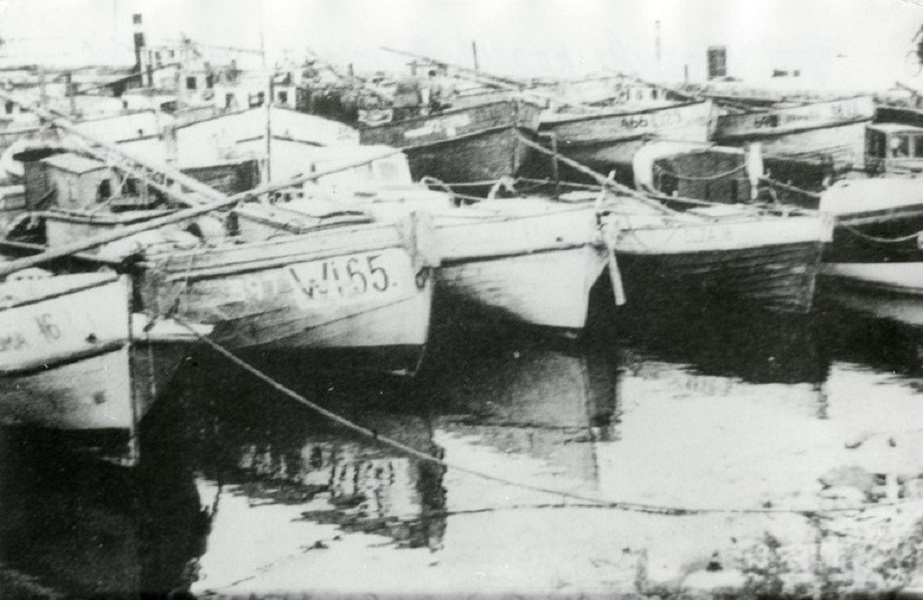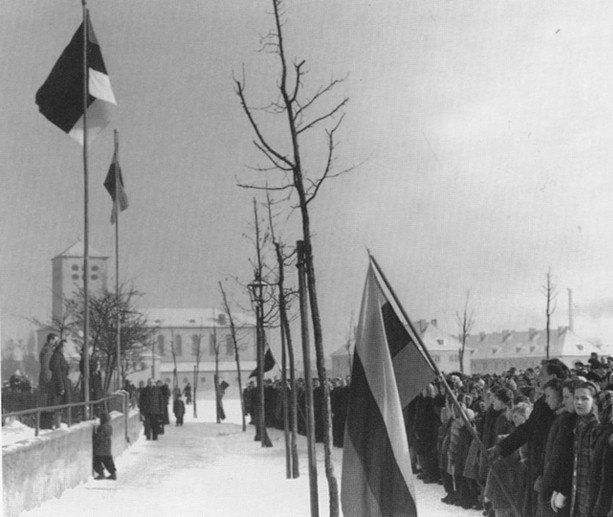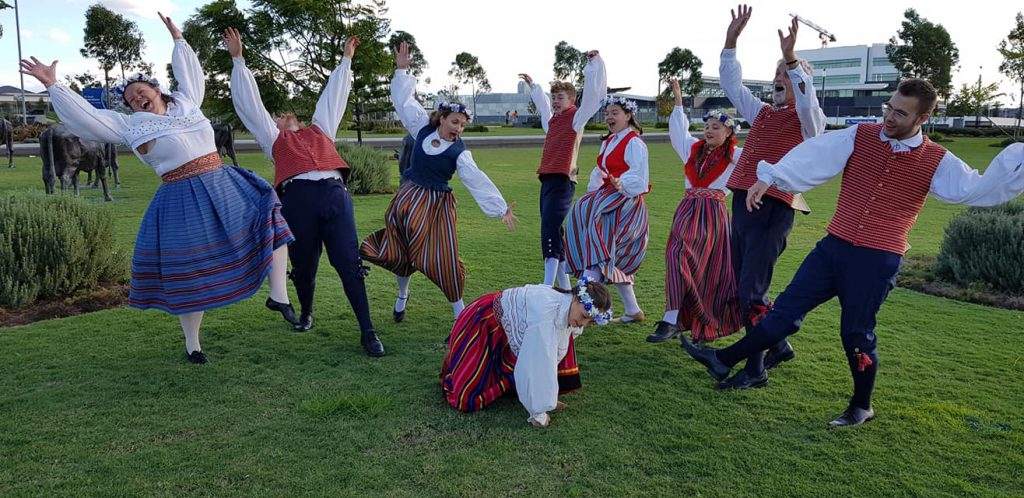In September 1944, fearful of the advancing Red Army, approximately 80,000 Estonians left their country behind and escaped to the West. Elin Toona, who was just 6 years old at the time, gave a speech on 19 September 2022 entitled, “Into exile – last refugee”, at an international conference in Tallinn memorialising the historical event; Estonian World publishes Toona’s speech with light edits for clarity.
When I was asked to speak to you today, the first image that came to mind was of a long muddy path through a forest, with just enough light to see the sky through the trees and occasional shafts of sunlight that reminded me of how we look at things differently when the light changes.
I was 6 years old when we first fled into the forest, escaping the March 1944 bombing of Estonia. We found shelter in Saunja Manor and felt safe in the middle of the woods, surrounded by swamps, in a large room full of refugees, each on their own pile of belongings.
The women spent the day in the kitchen cooking. The men arrived in the evening. We heard them at the back door, stamping their boots, coughing and slapping their gloves together. Their deep rumbling voices mingled with the excited chatter of the women – half whispering, half laughing – happy to see each other.
The men were bearded and grim looking, their clothes stiff, their limbs frozen. Those who hid in the woods at that time were known as the Forest Brothers. Our women helped them remove their heavy damp coats, scarves and ushankas (a Russian fur cap with ear covering flaps that can be tied up to the crown of the cap, or fastened at the chin to protect the ears, jaw, and lower chin from the cold – editor).
They all sat around the table to eat what the women had cooked. While they ate, I sat under the table and kept my eyes on my Grandmother’s shoes, because she was my only symbol of safety.
Still in Saunja, I had just been chased out of the kitchen. I was scared and went looking for Grandmother. I stepped out the back door, panicked. The snow was melting. I found a clump of snowflakes under a dome of ice. The sun was shining through the filigreed crystals, illuminating the white petals, green stems, and black soil with golden light. Cold gold was dripping from the sky.
I squatted there for a long time until Grandmother appeared beside me. “Ah, there you are”, she said. “I’ve been looking for you everywhere.” At that moment, the light changed in me too. Someone knew me and had missed me.

This summer – in 2022 – I and a couple of friends went looking for Saunja Manor – where we had sought shelter in 1944 and had felt safe. Our safe haven was a pile of stones overgrown with thorns and nettles.
About the same time in 1944, a neighbour came to our door. She told Grandmother she was fleeing to Sweden and left us the key to her front door – for when she would return. Leaving and returning is also ingrained into our psyche. It is what dreams are made of. Reality is what we wake up to. The key our neighbour left us no longer had a house or a front door when I returned in 1990.
When Mother, Grandmother and I fled Estonia in September that same year and reached Kuressaare beach, mother wanted a knife to cut a melon she had found in the ruins of the old castle. She was upset when she discovered Grandmother had only saved books and papers. But when we reached Berlin, it was my potty that was more valuable; our only container in which we carried water from public taps and horse troughs to the bomb shelter.
When our small boat pulled away from the shore, I looked back. The beach was littered with furniture, antiques, open boxes and suitcases, spilling their contents onto the sand – valuables when they left the house, worthless when they reached the beach. The only person still on the beach was an old woman, sitting on a mattress hugging a large grandfather clock. She had decided the clock was dearer than her life.

We were at sea when our boat began to take on water. A Polish freighter drew alongside and offered to rescue anyone brave enough to climb the rope ladder in the middle of the heaving Baltic. Only my Mother, young and agile, took up the offer. She persuaded the captain to winch me and Grandmother aboard in a fishing net, lined with a wooden box.
To this day, I have no idea whether our smaller boat reached Sweden or sank. As for the old woman left on the beach? She probably went back home with her clock and lived to be 100.
Running down a street during a bombing raid, a strafer began to shoot at me. Bullets hit the ground around me but instead of hiding, all I wanted to do was get back to the safety of my Grandmother. The need to get back to my own was stronger than fear – the same subconscious need that created communities, villages, towns and finally nations.
In Berlin, we lived in a cemetery. Mausoleums had survived but mansions had no front walls. I worried about what was under the gravestones we slept on. “Right now, it’s the living we need to worry about,” said Mother, adjusting my values and priorities for the future.

For our refugees who fled in 1944, of greatest value was our culture. They honoured it for 50 years – to this day. When Estonia was deep under Communism, forbidden to sing the national anthem, we abroad celebrated Independence Day, organised Saturday morning school classes at every level and in every free country in the world, to ensure that our culture would remain strong for the next generations.
Nations rise and fall, nationalities are shaken and people die, but it’s always vital to leave something for the survivors. You managed that here too, despite great danger, to the end. Think of it as the “yeast culture” every baker puts aside for the next batch, because survival depends on it. We all need our daily bread. And when I returned to Estonia, you had saved it for me. I thank you!
I’m now thinking of the three of us – Estonia, Latvia and Lithuania – and the Baltic chain in 1989, when we stood together, held hands and paved the way to the future. The future has arrived. The sand has shifted again, by forces greater than ours. If we cannot save our people, we can save our culture, in an untried universe, both mentally and physically. And perhaps for an even greater length of time than the ancient Egyptians did, on stone tablets. Only we don’t need stone tablets, we have our own incredible e-nation and start-ups, many invented right here in Estonia.
Grandmother’s choice was correct. Our culture was her most valuable possession.
I’m also thinking of our people. It is estimated that up to 200,000 people with Estonian roots live outside Estonia. Surveys show that 80 percent of them want to participate in our mutual future. They have raised two generations of culturally strong Estonians with a seriously patriotic vocation. If we lose Estonia, we no longer have a homeland.

This is the crisis now being faced in Ukraine. It seems logical and perhaps vital for us to unite as an extended family, greatly distanced from the doorstep of potential enemies, and thus create a much larger Estonia than one million blue, black and white flag wavers.
And you, dear, respected politicians, here today, can make it happen. We need to speak louder, call all our countrymen and allies to action and not hide our vital light under a bushel. I remember the English film, “The Mouse That Roared”. By connecting all Estonians globally, we can save our culture and spiritual values indefinitely. Thank you for giving me the floor, for letting me speak. Thanks!

